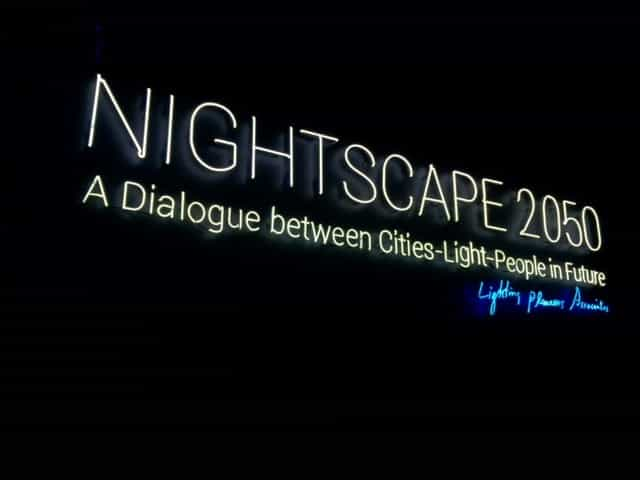LPA光の巡回展 Nightscape 2050(2015-2016)

趣旨
この展覧会は2050 年の人と光と街のあり方を探るためのものとして企画しました。
ここではNightscape =夜景を、単なる夜間の都市景観として捉えていない。私たちは夜景を「光と人と街のあるべき姿」として捉えました。
21 世紀に入り、LED などの新光源の出現とデジタル調光制御技術の進化は、私たちの生活情景を大きく変化させようとしています。それと同時に世界中に多発する自然災害や地球環境の変化、原子力災害などは、電力消費と照明デザインのあり方に真摯な議論を呼んでいます。
際限なく進化する光学技術は、利便性と共に光や影と自由に交わる楽しさを私たちに与えてくれます。しかしその陰で、サーカディアンリズムに変調をきたし光害を生む光環境も少なくありません。未来を語る時、人々と光との関わりには楽観論と悲観論の双方が混じり合っているのです。
照明デザインは「光と人々との素晴らしい出合い」をどのように創造できるのか。私たちは2050 年にどのような光環境を期待すべきなのか。この展覧会が「人と光と街との輝かしい未来」について世界中で語り合うためのプラットフォームとなることを期待しました。
巡回展の意味
この展覧会は世界の4都市を巡回するものとして企画されました。
先ずは、LPA=㈱ライティング プランナーズ アソシエーツが拠点を構える、Tokyo、Singapore、Hong Kongの3都市での開催が決まりましたが、アジアだけでなく欧米での批評も得るためにBerlin での開催を企画しました。今、欧米で最も新鮮な文化の風が流れる活気ある都市のひとつだからです。
Berlinでは2015年8月~10月にかけて2ヵ月の会期でした。多くのメディアにも紹介していただき話題の展覧会となりました。こどもワークショップを含む教育的なプログラムが評価され、学童をつれた教師の姿も多く見受けられました。
Singaporeでは2015年10月末からの1ヵ月の会期でした。Singaporeが建国50周年ということもあり、これからの都市照明の在り方を探るいい機会になりました。特に建国当時から現在までの都市照明の変遷を解説する年表は高い評価をいただきました。また、展示会場ではアトリウム空間を利用した夜間の照明演出を行い、多くの来場者がこれを楽しみました。
Hong Kongは2016年1月に1ヵ月間の展示でしたが、延べの来場者は19000人にのぼりました。4都市の会場の中で最も広く、特別に制作した光の体験展示を楽しむ家族連れの姿がたくさん見られました。香港夜景の現在を分析した展示も楽しいものになりました。
最終開催地の東京では2016年5月~6月の1か月の会期でした。展覧会の仕上げとなる東京では、この展覧会が都市を巡回したことの意味と成果を考えました。未来の街-光-人の在り方を話し合う場がどれほど深まったかは解りませんが、対話のきっかけになったことは確かなようです。異なる視点の論議が交わされ、照明技術がグローバルに展開することに対して、照明文化はローカルに展開していることを発見しました。異なる状況下の4都市は独特の文化を展開し、個性的な未来が期待されていることが解りました。
展覧会には4 都市を通して多くの方にお越しいただき、新聞、雑誌、テレビ、ラジオなどメディアの反響も大きいものがありました。こどもワークショップなどを開催したこともあり、会場には業界の方々のみならず家族連れの姿も見受けられました。照明デザインが少しずつ市民の生活にも浸透してきた感もありました。「光と人との素晴らしい出合い」を期待するためにも、多くの方々の批評に触れたことは私たちの喜びでありました。
開催地と会期
ベルリン: 2015年8月7日~10月1日@Aedes Gallery
シンガポール:2015年10月24日~11月21日@NATIONAL DESIGN CENTRE, SINGAPORE
香港:2016年1月8日~1月30日@ARTISTREE
東京:2016年5月14日~6月10日@TEMPORARY CONTEMPORARY
7つの共通コンテンツ
この展覧会は主に以下の7つのコンテンツと各都市独自の展示により構成されました。
1. Learning from Nature
私たちLPAの照明デザインの基本原理です。全ての私たちのデザインの所作は、太陽と火という二つの自然光が創り出す巧みな光と影の技に近づくためのものと考えています。
2. Learning from World Nightscapes
ここでは、LPAが25年間に調査収集した夥しい数の世界夜景の画像を駆使しました。そこではそれぞれの夜に固有の生活文化が息づいています。
3. Scenes from Nightscape 2050
Urban, Street, Park, Home, People, という5つのカテゴリーで未来を提案しました。予測論ではなく期待論に近いイメージが展開されました。
4 .Learning from Masters
私たちが気になっている5人の先達に、光との出合いと未来の光に対する期待の度合いを尋ねました。一つとして似通ったものがなく、個性的な回答をいただきました。
5. Learning from Children
9歳~13歳を中心にした子供たちとのワークショップを行いました。光の英雄と犯罪者を探しに夜の街に出た子供たち。私たちはそこから何を学び取れるでしょうか。
6. Who is LPA?
「建築照明デザインの潮流」という年表や、2015年に出版したばかりの書籍「LPA 1990-2015」を中心とした展示です。
7. Workshops and Symposiums
巡回展それぞれの都市で会期中に行われる個別のワークショップやシンポジウムです。
巡回展スポンサー:
株式会社Modulex / ALTO CO., Ltd. /コイズミ照明株式会社 /大光電機株式会社 / Luci Pte. Ltd. / Lutron Electronics /株式会社遠藤照明 /トキ・コーポレーション株式会社 / ERCO Lighting Pte. Ltd. / iGuzzini / Zumtobel Lighting G mbH / カラーキネティクス・ジャパン株式会社 /パナソニック株式会社 / WE-EF LIGHTING / Lumenpulse
技術協力:
First Design System Inc. / Julia Japan Inc.
協力
武蔵野美術大学/ 高橋英明/ 吉田悠/ 二反田和樹